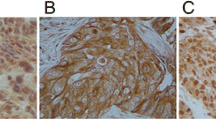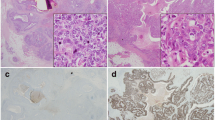Abstract
Purpose
Paclitaxel is an important agent in the pharmacological treatment of metastatic breast cancer. Despite its efficacy in selected patients, the majority of patients have a resistance against paclitaxel. The aim of this study was to identify the responding patients and hence prevent the other patients from ineffective treatment. Identifying these patients could spare them an ineffective treatment and could in turn characterize a subgroup of patients with a higher response rate.
Material and methods
Thirty-three patients with metastatic breast cancer received paclitaxel 175 mg/m2 either as first- (15 patients) or as second-line (18 patients) treatment. Immunohistochemistry was performed on the blocks of the primary tumors with monoclonal antibodies against p53, HER-2/neu, P-glycoprotein, Glutathione-S-Transferase-π, and β-tubulin II. The expression of those factors was then correlated with the objective response to paclitaxel.
Results
Ten of 33 patients had an objective response to treatment. A significant correlation with the objective response was found for the expression of p53. None of the tumors with p53 expression (n=11) responded to paclitaxel. In contrast, 10 of the 22 patients without p53 expression showed an objective response (P=0.013). Expression of HER-2/neu, P-glycoprotein, Glutathione-S-Transferase-π, and β-tubulin II did not show a correlation with the response to paclitaxel.
Conclusion
The immunohistochemical detection of p53 characterizes patients with metastatic breast cancer unlikely to respond to paclitaxel.






Similar content being viewed by others
References
Arrick BA, Nathan CF (1984) Glutathione metabolism as a determinant of therapeutic efficacy: a review. Cancer Res 44:4224–4232
Baselga J, Seidman AD, Rosen PP, Norton L (1997) HER2 overexpression and paclitaxel sensitivity in breast cancer: therapeutic implications. Oncology 11[Suppl 2]:43–48
Bishop JF, Dewar J, Toner G, Smith J, Tattersall MH, Olver I, Ackland S, Kennedy I, Goldstein D, Gurney H, Walpole E, Levi J, Stephenson J, Canetta R (1999) Initial paclitaxel improves outcome compared with CMFP combination chemotherapy as front-line therapy in untreated metastatic breast cancer. JCO 17:2355–2364
Bradley G, Naik M, Ling V (1989) P-Glykoprotein expression in multidrug resistant human ovarian carcinoma cell lines. Cancer Res 49:2790–2796
Cassinelli G, Supino R, Perego P, Polizzi D, Lanzi C, Pratesi G, Zunino F (2001) A role for loss of p53 function in sensitivity of ovarian carcinoma cells to taxanes. Int J Cancer 92:738–747
Chadderton A, Villeneuve DJ, Gluck S, Kirwan-Rhude AF, Gannon BR, Blais DE, Parissenti AM (2000) Role of specific apoptotic pathways in the restoration of paclitaxel-induced apoptosis by valspodar in doxorubicin-resistant MCF-7 breast cancer cells. Breast Cancer Res Treat 59:231–244
Das GC, Holiday D, Gallardo R, Haas C (2001) Taxol-induced cell cycle arrest and apoptosis: dose response relationship in lung cancer cells of different wild-type p53 status under isogenic condition. Cancer Lett 165:147–153
Derry WB, Wilson L, Jordan MA (1995) Substoichiometric binding of taxol suppresses microtubule dynamics. Biochem 34:2203–2211
Dirven HA, van Ommen B, van Bladeren PJ (1994) Involvement of human glutathione S-transferase isoenzymes in the conjugation of cyclophosphamide metabolites with glutathione. Cancer Res 54:6215–6220
Eck L, Pavich D, Fruehauf JP (1993) MDR-1 expression by human ovarian tumors is associated with taxol resistance. Proc Am Assoc Cancer Res 34:232
Gan YB, Balturshot G, Millenbaughm NJ, Chen CT, Kalns JE, Lim C, Wientjes MG, Au JL (1995) P-Glykoproteinexpression in human tumors and its correlation with chemosensitivity to taxol and cell mobility. Proc Am Assoc Cancer Res 36:334
Gan YB, Wientjes MG, Au JL (1998) Relationship between paclitaxel activity and pathobiology of human solid tumors. Clin Cancer Res 4:2949–2955
Giannakakou P, Poy G, Zhan Z, Knutsen T, Blagosklonny MV, Fojo T (2000) Paclitaxel selects for mutant or pseudo-null p53 in drug resistance associated with tubulin mutations in human cancer. Oncogene 19:3078–3085
Gurnani M, Lipari P, Dell J, Shi B, Nielsen LL (1999) Adenovirus-mediated p53 gene therapy has greater efficacy when combined with chemotherapy against human head and neck, ovarian, prostate and breast cancer. Cancer Chemother Pharmacol 44:143–151
Haber M, Burkhart CA, Regl DL, Madafiglio J, Norris MD, Horwitz SB (1995) Altered expression of M beta 2, the class II beta-tubulin isotype, in an murine J774.2 cell line with a high level of taxol resistance. J Biol Chem 270:31269–31275
Kandioler-Eckersberger D, Ludwig C, Rudas M, Kappel S, Janschek E, Wenzel C, Schlagbauer-Wadl H, Mittlboeck M, Gnant M, Steger G, Jakesz R (2000) TP53 mutation and p53 overexpression for prediction of response to neoadjuvant treatment in breast cancer patients. Clin Cancer Res 6:50–56
Lanni JS, Lowe SW, Licitra EJ, Liu JO, Jacks T (1997) p-53 independent apoptosis induced by paclitaxel through an indirect mechanism. Proc Natl Acad Sci USA 94:9679–9683
Linn SC, Pinedo HM, van Ark-Otte J, van der Valk P, Hoekman K, Honkoop AH, Vermorken J, Giaccone G (1997) Expression of drug resistance proteins in breast cancer, in relation to chemotherapy. Int J Cancer 71:787–795
Lowe SW, Bodis S, McClatchey A, Remington L, Ruley HE, Fisher DE, Housman DE, Jacks T (1994) p53 status and the efficacy of cancer therapy in vivo. Science 266:807–810
Luduena RF (1998) Multiple forms of tubulin: different gene products and covalent modifications. Int Rev Cytol 178:207–275
Mallarino MC, Duran GE, Dumontet CM, Sikic BI (1995). Mechanisms of resistance in a human sarcoma cell line continuously selected with paclitaxel (Taxol, TAX) and SDZ PSC 833. Proc Am Assoc Cancer Res 36:320
Masanek U, Stammler G, Volm M (1997) Messenger RNA expression of resistance proteins and related factors in human ovarian carcinoma cell lines resistant to doxorubicin, taxol and cisplatin. Anti-Cancer Drugs 8:189–198
Mechetner E, Kyshtoobayeva A, Zonis S, Kim H, Stroup R, Garcia R, Parker RJ, Fruehauf JP (1998) Levels of multidrug resistance (MDR-1) P-glycoprotein expression by human breast cancer correlate with in vitro resistance to taxol and doxorubicin. Clin Cancer Res 4:389–398
Meijer C, Mulder NH, De Vries EGE (1990) The role of detoxifying systems in resistance of tumor cells to cisplatin and adriamycin. Cancer Treat Rev 7:389–407
Michael M, Bishop JF, Levi JA, Bell DR, Zalcberg JR, Friedlander ML, Olver IN, Smith JG, Toner GC (1997) Australian multicenter phase II trial of paclitaxel in women with metastatic breast cancer and prior chemotherapy. Med J Austral 10:520–523
Milross CG, Mason K, Hunter NR, Chung VK, Peters LJ, Milas L (1996) Relationship of mitotic arrest and apoptosis to antitumor effect of paclitaxel. J Natl Cancer Inst 88:1308–1314
Nicoletti MI, Valoti G, Giannakakou P, Zhan Z, Kim JH, Lucchini V, Landoni F, Mayo JG, Giavazzi R, Fojo T (2001) Expression of beta-tubulin isotypes in human ovarian carcinoma xenografts and in a sub-panel of human cancer cell lines from the NCI-Anticancer Drug Screen: correlation with sensitivity to microtubule active agents. Clin Cancer Res 7:2912–2922
Nielsen LL, Lipari P, Dell J, Gurnani M, Hajian G (1998) Adenovirus-mediated p53 gene therapy and paclitaxel have synergistic efficacy in models of human head and neck, ovarian, prostate, and breast cancer. Clin Cancer Res 4:835–846
Oldham EA, Li C, Ke S, Wallace S, Huang P (2000) Comparison of action of paclitaxel and poly(L-glutamic acid)-paclitaxel conjugate in human breast cancer cells. Int J Oncol 16:125–132
Orr MS, O´Connor PM, Kohn KW (2000) Effects of c-erbB2 overexpression on the drug sensitivities of normal human mammary epithelial cells. J Natl Cancer Inst 92:987–994
Rouby S, Thomas A, Costin D, Rosenberg CR, Potmesil M (1993) p53 mutation in B-cell chronic lymphocytic leukemias associated with drug resistance and is independent of MDR1/MDR3 gene expression. Blood 82:3452–3459
Schiff PB, Fant J, Horwitz SB (1979). Promotion of microtubule assembly in vitro by taxol. Nature 277:665–667
Shiga H, Heath EI, Rasmussen AA, Trock B, Johnston PG, Forastiere AA, Langmacher M, Baylor A, Lee M, Cullen KJ (1999) Prognostic value ofp53, glutathione-S-transferase π, and thymidylate synthase for neoadjuvant cisplatin-based chemotherapy in head and neck cancer. Clin Cancer Res 5:4097–4104
Shimizu C, Fukutomi T, Tsuda H, Akashi-Tanaka S, Watanabe T, Nanasawa T, Sugihara K (2000) c-erbB-2 protein overexpression and p53 immunoreaction in primary and recurrent breast cancer tissues. J Surg Oncol 73:17–20
Soong R, Robbins PD, Dix BR, Grieu F, Lim B, Knowles S, Williams KE, Turbett GR, House AK, Iacopetta BJ (1996) Concordance between p53 protein overexpression and gene mutation in a large series of common human carcinomas. Hum Pathol 27:1050–1055
Ueno NT, Bartholomeusz C, Herrmann JL, Estrov Z, Shao R, Andreeff M, Price J, Paul RW, Anklesaria P, Yu D, Hung MC (2000) E1A-mediated paclitaxel sensitisation in HER-2/neu-overexpressing ovarian cancer SKOV3.ip1 through apoptosis involving the caspase-3 pathway. Clin Cancer Res 6:250–259
van Ark-Otte J, Samelis G, Rubio G, Lopez Saez JB, Pinedo HM, Giaccone G (1998) Effects of tubulin-inhibiting agents in human lung and breast cancer cell lines with different multidrug resistance phenotypes. Oncol Rep 5:249–255
van Poznak C, Tan L, Panageas KS, Arroyo CD, Hudis C, Norton L, Seidmann AD (2002) Assessment of molecular markers of clinical sensitivity to single-agent taxane therapy for metastatic breast cancer. JCO 20:2319–2326
Wahl AF, Donaldson KL, Fairchild C, Lee FY, Foster SA, Demers GW, Galloway DA (1996) Loss of normal p53 function confers sensitisation to taxol by increasing G2/M arrest and apoptosis. Nature Med 2:72–79
Woods CM, Zhu J, McQueney PA, Bollag D, Lazarides E (1995) Taxol-induced mitotic block triggers rapid onset of a p53-independent apoptotic pathway. Molec Med 1:506–526
Yamamoto N, Watanabe T, Katsumata N, Omuro Y, Ando M, Fukuda H, Tokue Y, Narabayashi M, Adachi I, Takashima S (1998) Construction and validation of a practical prognostic index for patients with metastatic breast cancer. J Clin Oncol 16:2401–2408
Yang X, Uziely B, Groshen S, Lukas J, Israel V, Russell C, Dunnington G, Formenti S, Muggia F, Press MF (1999) MDR1 gene expression in primary and advanced breast cancer. Lab Invest 79:271–280
Yu D, Liu B, Tan M, Li J, Wang SS, Hung MC (1996) Overexpression of c-erbB-2/neu in breast cancer cells confers increased resistance to taxol via mdr-1-independent mechanisms. Oncogene 13:1359–1365
Zhang L, Lau YK, Xia W, Hortobagyi GN, Hung MC (1999) Tyrosise kinase inhibitor emodin suppresses growth of HER-2/neu-overexpressing breast cancer cells in athymic mice and sensitises these cells to the inhibitory effect of paclitaxel. Clin Cancer Res 5:343–353
Author information
Authors and Affiliations
Corresponding author
Additional information
This study was supported in part by a grant from Bristol Myers Squibb. The results were partly presented at the annual meeting of the German Society for Senology in Berlin 2001.
Rights and permissions
About this article
Cite this article
Schmidt, M., Bachhuber, A., Victor, A. et al. p53 expression and resistance against paclitaxel in patients with metastatic breast cancer. J Cancer Res Clin Oncol 129, 295–302 (2003). https://doi.org/10.1007/s00432-003-0430-1
Received:
Accepted:
Published:
Issue Date:
DOI: https://doi.org/10.1007/s00432-003-0430-1




